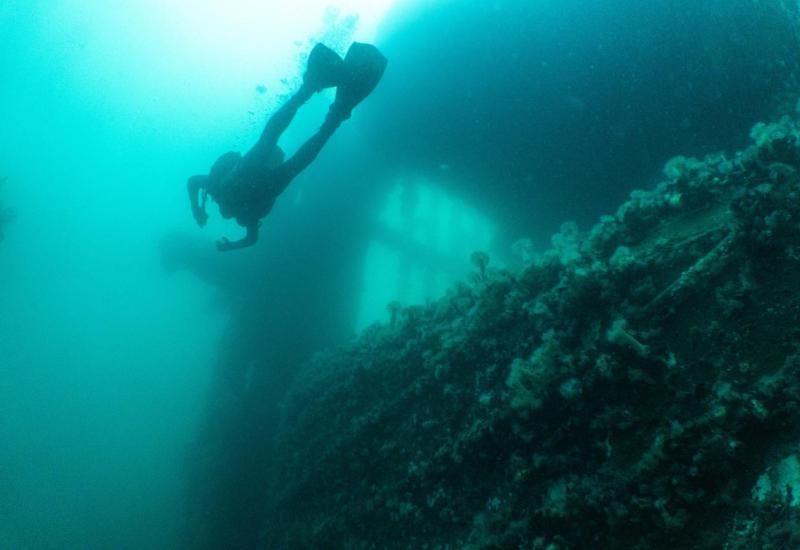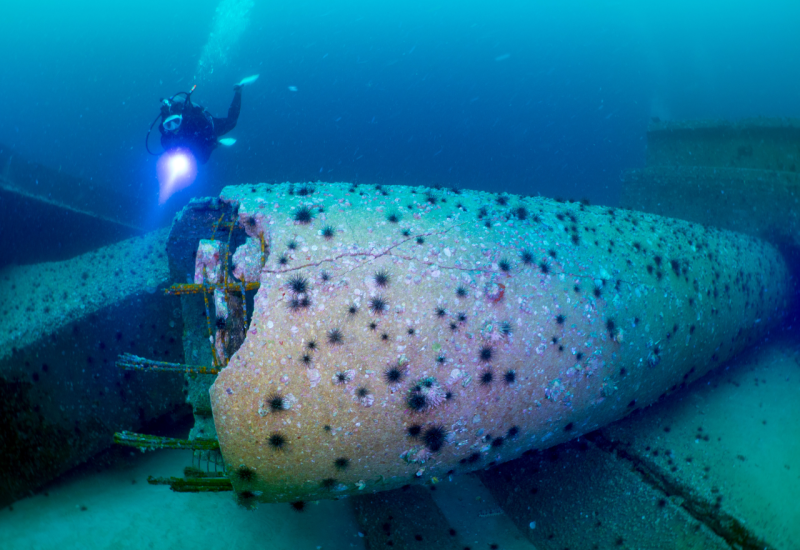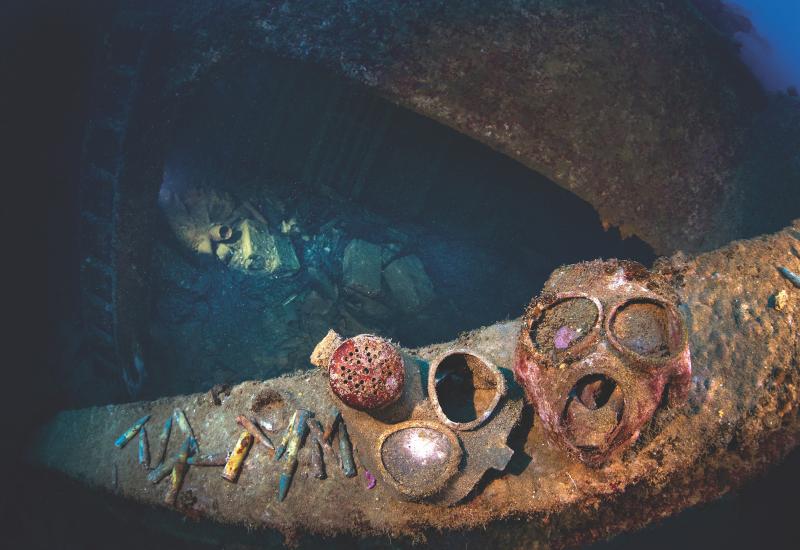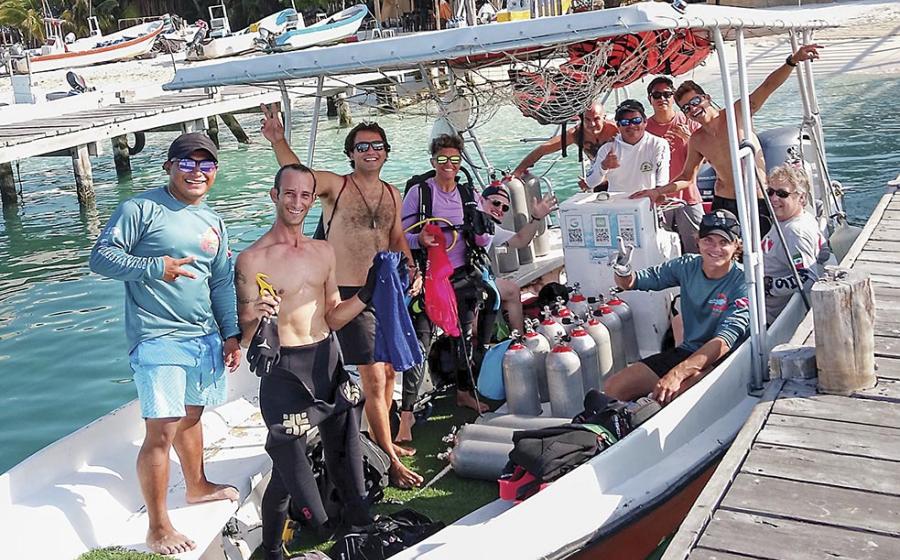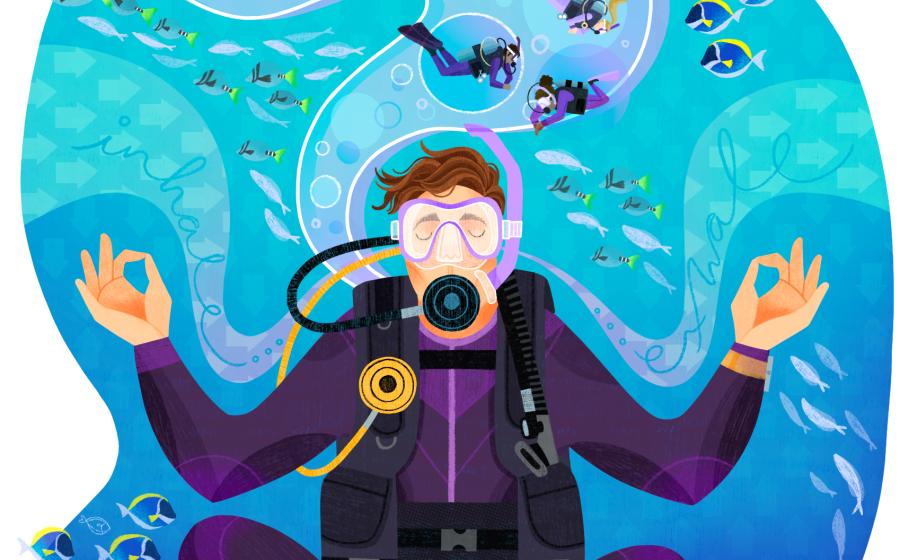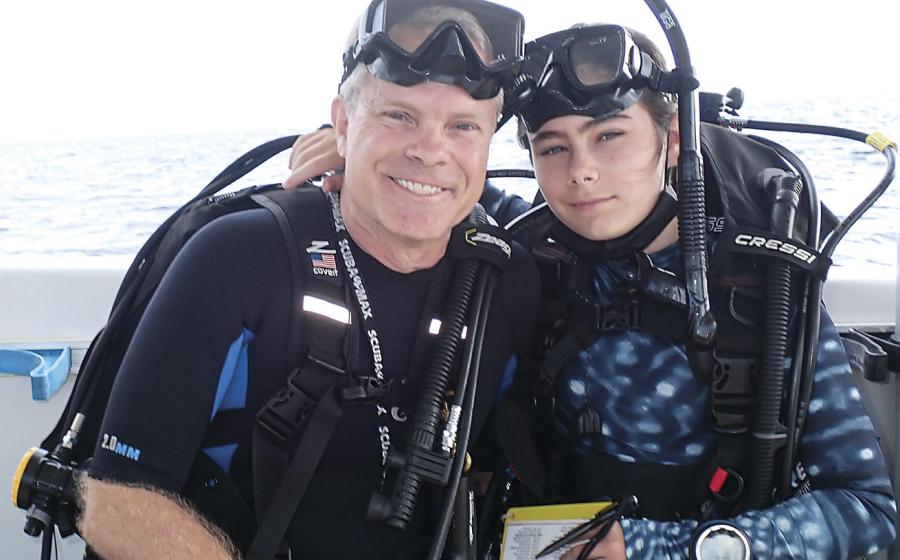Diving the Florida Panhandle Shipwreck Trail
Let’s start with the biggest: the 888-foot USS Oriskany. Diving the world’s largest artificial reef is all my buddy and I talk about on the drive from Orlando to Pensacola, Florida. So we’re a bit disappointed when we learn our frst dive will be on the rubbly remains of the 315-foot San Pablo.
As we soon find out, we should have been excited. “We have hundreds of dive sites, but until Oriskany no one knew about our diving,” says Capt. Douglas Hammock, at the helm of H2O Below as we pull away from the marina. “San Pablo is actually a great dive.”
When San Pablo exploded of Pensacola’s coast in 1944, locals conjured tales of espionage and foreign spies, and dubbed the wreck the “Russian Freighter.” But Franklin Price, a maritime archaeologist with the Florida Department of State, explains during our briefing what really happened to the ship. “It was a refrigerated cargo carrier that brought bananas up to Boston from Central America for years. It was torpedoed in 1942 at the dock in Puerto Limon in Costa Rica by a Nazi U-boat.” Franklin says that the ship was refloated and towed to the United States in 1944, and blown up during a top-secret government mission. The facts about San Pablo’s sinking were revealed only a few years ago, so the moniker Russian Freighter still persists among local divers.
We’ve come to explore four of the 12 wrecks on the Florida Panhandle Shipwreck Trail: San Pablo, the former fleet tug Accokeek, the Twin Tugs and the Oriskany. The state of Florida’s Bureau of Archaeological Research created the trail; working with local dive operators, the bureau chose the wrecks for the overall quality of their diving, ease of accessibility and historic signifcance. Price says that if you know what you’re looking at, the San Pablo is a fascinating dive. “You get to see the history — the refrigeration coils from when it was a banana boat. You also see the carnage from when it was destroyed.” Chris Hicks, one of the divemasters with H2O Below, chimes in: “It has more marine life than many of the other wrecks — the variety of life on San Pablo is a constant, no matter when you dive it.”
Both men are right: The damage is evident — more than 3,000 pounds of explosives were used during the Navy’s target practice — but so are the number of tropicals and bigger fish like red snapper, amberjack, and goliath grouper swirling above and around the wreck. A sandbar shark swims of as the first divers descend. We circle intact parts like the boilers from the steam engines, and dip in where explosives ripped the boat apart, finding macro critters like arrow crabs that have claimed a piece of twisted-metal real estate.
Also on the boat with us is Robert Turpin, marine resources manager for Escambia County. Turpin checks the status of the marine life on the wrecks several times a year. San Pablo is special to Turpin: He made his first dives on it in 1975. “Everybody deserves to know this is here,” Turpin tells me, but I don’t need more convincing. San Pablo is a great introduction to Pensacola diving.
THE “GREAT CARRIER REEF”
While Turpin has a connection to the San Pablo, he has an even bigger one to the Oriskany. “My stepdad served on the Oriskany, and I got to be part of the ship’s sinking,” he says. “A part of me is in that ship— blood, sweat and tears.”
The Oriskany — sunk in May 2006, 22 miles of Pensacola — has quite a history. According to the Florida Panhandle Shipwreck Trail website, “Built shortly after World War II, the Mighty O served primarily in the Pacific, earning two battle stars for service in the Korean War and 10 battle stars in the Vietnam War.” Sen. John McCain’s final bombing mission was from the Oriskany — on Oct. 26, 1967, he was shot down and became a prisoner of war for more than fve years.
Its massive size — about the length of three football fields — means you can’t see it all on one dive. “It’s the biggest thing that I have been diving on — the tower alone is bigger than many of the shipwrecks that I’ve dived,” says Price. Its depth also dictates your profile; you need extended-range certification to dive the ship’s fight deck, which is located at 145 feet. We spend all our time on the barnacled control tower of the massive wreck. The top of the smokestack is at about 80 feet, and you can keep within recreational limits of 130 feet as you descend down on the tower.
We’re entertained by barracuda, snapper and amberjack cruising the ship, but despite trying, we can’t visually take in the ship’s length. It’s not until our safety stop, looking down, where we can truly appreciate the Mighty O’s immense size. This colossal wreck has earned its nickname.
PANAMA CITY WRECKS
For our last day of diving the Shipwreck Trail, we make the drive to Panama City to explore the Twin Tugs and Accokeek aboard Steel Slinger. Officially called the FAMI Tugs (Florida Aquatic and Marine Institute), the Twin Tugs were originally put down bow to bow, but a Gulf storm pushed one atop the other — it’s an interesting photo op on the way down or up. Fortunately for us, the only storm this day is a fish one—the tugs are smothered by a tornado of snapper and jacks. The shipwrecks rest between 85 and 95 feet; their positioning makes it look as if they’ve collided underwater — it’s sobering to think about the power of the ocean. “It’s mind-boggling that a storm actually lifted one up and placed it atop the other,” says Price, after we’ve reached the surface.
If diving on the tugs demonstrates the power of Mother Nature, on our next dive, on the 143-foot Accokeek, we come face to face with one of nature’s most fearless fish, Atlantic goliath grouper — three of them, all seeming to stalk us. Known to attack lemon sharks, goliaths can get huge — the world record for a hook-and-line specimen is 681 pounds, caught off Fernandina Beach, Florida, in 1961. “This wreck reliably produces goliath grouper encounters,” says Capt. Pat Green of Panama City Diving. “The big resident is over 500 pounds, and not as shy as some of the goliaths on other wrecks.” Indeed. These three are all in the 400- to 500-pound range. They look like thickset, defensive linemen in search of a meal after a big football game. Amazing fish.
Diving the former Navy supply ship, with its rec-friendly wheelhouse at 65 feet, is not only the perfect ending to our weekend of wreck diving, but it’s also a reminder that we still have plenty more to explore beyond the beautiful white-sand beaches of the Panhandle.
Itinerary
DAY 1
Eat dinner and enjoy the sunset over Pensacola Bay, at the Grand Marlin Restaurant and Oyster Bar, located on the Pensacola Beach side of the Bob Sikes Bridge. To ensure that the freshest ingredients are being used, the restaurant’s chef Gregg McCarthy changes the menu daily at this elegant eatery. Prefer your fish under the sea? Steaks, chicken and vegetarian options are available. To get there from Pensacola, cross the Pensacola Bay Bridge (locals call it the Three-Mile Bridge) into Gulf Breeze, and take Hwy. 98 to the Pensacola Beach exit. Cross the Bob Sikes Bridge, and make an immediate left onto the service road to the restaurant.
DAY 2
After making two dives on the Mighty O, it was late afternoon before we returned to the marina. We sat down for an early dinner at the picturesque Red Fish Blue Fish on Via De Luna in Pensacola Beach. The restaurant is shabby-chic — it was built using repurposed shipping containers and Indonesian boat wood — and has delightful views of the bay. For your entree, choose between burgers, po’ boys and seafood baskets prepared any way you like — just be sure to order the carne fries appetizer: hand-cut potatoes topped with Mexican spiced beef in gravy, sautéed green peppers and onions, and shredded cheese. You won’t be disappointed.
DAY 3
If you’ve got time for a surface interval, visit YOLO Board + Bike, at the intersection of 30A and 393 in Santa Rosa Beach, to rent a stand-up paddle board or demo newly designed gear. Never tried SUP? Sign up for a lesson with YOLO Board Adventure at the WaterColor BoatHouse on Western Lake in Santa Rosa Beach. One lesson, including paddle board and paddle rental, costs $55 per person for groups of three or more. After burning some calories, we had lunch at Bud & Alley’s on 30-A in Seaside. The restaurant prides itself on making locally sourced food; the grilled eggplant and zucchini sandwich was a winner. So was our rooftop view.

David BenzThe Florida Panhandle Shipwreck Trail includes a bevy of dive sites, including the Twin Tugs (pictured) and the Oriskany.
Let’s start with the biggest: the 888-foot USS Oriskany. Diving the world’s largest artificial reef is all my buddy and I talk about on the drive from Orlando to Pensacola, Florida. So we’re a bit disappointed when we learn our frst dive will be on the rubbly remains of the 315-foot San Pablo.
As we soon find out, we should have been excited. “We have hundreds of dive sites, but until Oriskany no one knew about our diving,” says Capt. Douglas Hammock, at the helm of H2O Below as we pull away from the marina. “San Pablo is actually a great dive.”

David BenzThe Florida Panhandle Shipwreck Trail includes a bevy of dive sites, including the Twin Tugs and the Oriskany (pictured).
When San Pablo exploded of Pensacola’s coast in 1944, locals conjured tales of espionage and foreign spies, and dubbed the wreck the “Russian Freighter.” But Franklin Price, a maritime archaeologist with the Florida Department of State, explains during our briefing what really happened to the ship. “It was a refrigerated cargo carrier that brought bananas up to Boston from Central America for years. It was torpedoed in 1942 at the dock in Puerto Limon in Costa Rica by a Nazi U-boat.” Franklin says that the ship was refloated and towed to the United States in 1944, and blown up during a top-secret government mission. The facts about San Pablo’s sinking were revealed only a few years ago, so the moniker Russian Freighter still persists among local divers.

David BenzMuch mystery surrounded the sinking of this former fruit transport's sinking in 1944. Locals still call her the "Russian Freighter." Turns out, she was destroyed in a top-secret U.S. military operation that tested an experimental weapon.
We’ve come to explore four of the 12 wrecks on the Florida Panhandle Shipwreck Trail: San Pablo, the former fleet tug Accokeek, the Twin Tugs and the Oriskany. The state of Florida’s Bureau of Archaeological Research created the trail; working with local dive operators, the bureau chose the wrecks for the overall quality of their diving, ease of accessibility and historic signifcance. Price says that if you know what you’re looking at, the San Pablo is a fascinating dive. “You get to see the history — the refrigeration coils from when it was a banana boat. You also see the carnage from when it was destroyed.” Chris Hicks, one of the divemasters with H2O Below, chimes in: “It has more marine life than many of the other wrecks — the variety of life on San Pablo is a constant, no matter when you dive it.”

David BenzOfficially called the FAMI Tugs, everyone refers to them as the Twin Tugs. The tugs once rested bow to bow, joined by a 30-foot tether, but a storm rearranged them so that one tug now rests atop the other.
Both men are right: The damage is evident — more than 3,000 pounds of explosives were used during the Navy’s target practice — but so are the number of tropicals and bigger fish like red snapper, amberjack, and goliath grouper swirling above and around the wreck. A sandbar shark swims of as the first divers descend. We circle intact parts like the boilers from the steam engines, and dip in where explosives ripped the boat apart, finding macro critters like arrow crabs that have claimed a piece of twisted-metal real estate.
Also on the boat with us is Robert Turpin, marine resources manager for Escambia County. Turpin checks the status of the marine life on the wrecks several times a year. San Pablo is special to Turpin: He made his first dives on it in 1975. “Everybody deserves to know this is here,” Turpin tells me, but I don’t need more convincing. San Pablo is a great introduction to Pensacola diving.

David BenzAccokeek has an impressive service record: She towed damaged ships from the invasion of Okinawa, transited the Panama Canal, and assisted navy vessels ranging from cruisers to submarines. Three huge goliath grouper showed up on this dive.
THE “GREAT CARRIER REEF”
While Turpin has a connection to the San Pablo, he has an even bigger one to the Oriskany. “My stepdad served on the Oriskany, and I got to be part of the ship’s sinking,” he says. “A part of me is in that ship— blood, sweat and tears.”
The Oriskany — sunk in May 2006, 22 miles of Pensacola — has quite a history. According to the Florida Panhandle Shipwreck Trail website, “Built shortly after World War II, the Mighty O served primarily in the Pacific, earning two battle stars for service in the Korean War and 10 battle stars in the Vietnam War.” Sen. John McCain’s final bombing mission was from the Oriskany — on Oct. 26, 1967, he was shot down and became a prisoner of war for more than fve years.

David BenzThis 143-foot-long former fleet tug was purpose-sunk in 2000.
Its massive size — about the length of three football fields — means you can’t see it all on one dive. “It’s the biggest thing that I have been diving on — the tower alone is bigger than many of the shipwrecks that I’ve dived,” says Price. Its depth also dictates your profile; you need extended-range certification to dive the ship’s fight deck, which is located at 145 feet. We spend all our time on the barnacled control tower of the massive wreck. The top of the smokestack is at about 80 feet, and you can keep within recreational limits of 130 feet as you descend down on the tower.
We’re entertained by barracuda, snapper and amberjack cruising the ship, but despite trying, we can’t visually take in the ship’s length. It’s not until our safety stop, looking down, where we can truly appreciate the Mighty O’s immense size. This colossal wreck has earned its nickname.

David BenzNo. 23
Oriskany, Pensacola, Florida
Best Wreck Diving
PANAMA CITY WRECKS
For our last day of diving the Shipwreck Trail, we make the drive to Panama City to explore the Twin Tugs and Accokeek aboard Steel Slinger. Officially called the FAMI Tugs (Florida Aquatic and Marine Institute), the Twin Tugs were originally put down bow to bow, but a Gulf storm pushed one atop the other — it’s an interesting photo op on the way down or up. Fortunately for us, the only storm this day is a fish one—the tugs are smothered by a tornado of snapper and jacks. The shipwrecks rest between 85 and 95 feet; their positioning makes it look as if they’ve collided underwater — it’s sobering to think about the power of the ocean. “It’s mind-boggling that a storm actually lifted one up and placed it atop the other,” says Price, after we’ve reached the surface.

Courtesy Grand Marlin RestaurantEat dinner and enjoy the sunset over Pensacola Bay, at the Grand Marlin Restaurant and Oyster Bar, located on the Pensacola Beach side of the Bob Sikes Bridge. To ensure that the freshest ingredients are being used, the restaurant’s chef Gregg McCarthy changes the menu daily at this elegant eatery. Prefer your fish under the sea? Steaks, chicken and vegetarian options are available. To get there from Pensacola, cross the Pensacola Bay Bridge (locals call it the Three-Mile Bridge) into Gulf Breeze, and take Hwy. 98 to the Pensacola Beach exit. Cross the Bob Sikes Bridge, and make an immediate left onto the service road to the restaurant.
After making two dives on the Mighty O, it was late afternoon before we returned to the marina. We sat down for an early dinner at the picturesque Red Fish Blue Fish on Via De Luna in Pensacola Beach. The restaurant is shabby-chic — it was built using repurposed shipping containers and Indonesian boat wood — and has delightful views of the bay. For your entree, choose between burgers, po’ boys and seafood baskets prepared any way you like — just be sure to order the carne fries appetizer: hand-cut potatoes topped with Mexican spiced beef in gravy, sautéed green peppers and onions, and shredded cheese. You won’t be disappointed.

Courtesy Red Fish Blue Fish Restaurant
If diving on the tugs demonstrates the power of Mother Nature, on our next dive, on the 143-foot Accokeek, we come face to face with one of nature’s most fearless fish, Atlantic goliath grouper — three of them, all seeming to stalk us. Known to attack lemon sharks, goliaths can get huge — the world record for a hook-and-line specimen is 681 pounds, caught off Fernandina Beach, Florida, in 1961. “This wreck reliably produces goliath grouper encounters,” says Capt. Pat Green of Panama City Diving. “The big resident is over 500 pounds, and not as shy as some of the goliaths on other wrecks.” Indeed. These three are all in the 400- to 500-pound range. They look like thickset, defensive linemen in search of a meal after a big football game. Amazing fish.

ShutterstockIf you’ve got time for a surface interval, visit YOLO Board + Bike, at the intersection of 30A and 393 in Santa Rosa Beach, to rent a stand-up paddle board or demo newly designed gear. Never tried SUP? Sign up for a lesson with YOLO Board Adventure at the WaterColor BoatHouse on Western Lake in Santa Rosa Beach. One lesson, including paddle board and paddle rental, costs $55 per person for groups of three or more. After burning some calories, we had lunch at Bud & Alley’s on 30-A in Seaside. The restaurant prides itself on making locally sourced food; the grilled eggplant and zucchini sandwich was a winner. So was our rooftop view.
Diving the former Navy supply ship, with its rec-friendly wheelhouse at 65 feet, is not only the perfect ending to our weekend of wreck diving, but it’s also a reminder that we still have plenty more to explore beyond the beautiful white-sand beaches of the Panhandle.
Itinerary
DAY 1
Eat dinner and enjoy the sunset over Pensacola Bay, at the Grand Marlin Restaurant and Oyster Bar, located on the Pensacola Beach side of the Bob Sikes Bridge. To ensure that the freshest ingredients are being used, the restaurant’s chef Gregg McCarthy changes the menu daily at this elegant eatery. Prefer your fish under the sea? Steaks, chicken and vegetarian options are available. To get there from Pensacola, cross the Pensacola Bay Bridge (locals call it the Three-Mile Bridge) into Gulf Breeze, and take Hwy. 98 to the Pensacola Beach exit. Cross the Bob Sikes Bridge, and make an immediate left onto the service road to the restaurant.
DAY 2
After making two dives on the Mighty O, it was late afternoon before we returned to the marina. We sat down for an early dinner at the picturesque Red Fish Blue Fish on Via De Luna in Pensacola Beach. The restaurant is shabby-chic — it was built using repurposed shipping containers and Indonesian boat wood — and has delightful views of the bay. For your entree, choose between burgers, po’ boys and seafood baskets prepared any way you like — just be sure to order the carne fries appetizer: hand-cut potatoes topped with Mexican spiced beef in gravy, sautéed green peppers and onions, and shredded cheese. You won’t be disappointed.
DAY 3
If you’ve got time for a surface interval, visit YOLO Board + Bike, at the intersection of 30A and 393 in Santa Rosa Beach, to rent a stand-up paddle board or demo newly designed gear. Never tried SUP? Sign up for a lesson with YOLO Board Adventure at the WaterColor BoatHouse on Western Lake in Santa Rosa Beach. One lesson, including paddle board and paddle rental, costs $55 per person for groups of three or more. After burning some calories, we had lunch at Bud & Alley’s on 30-A in Seaside. The restaurant prides itself on making locally sourced food; the grilled eggplant and zucchini sandwich was a winner. So was our rooftop view.

